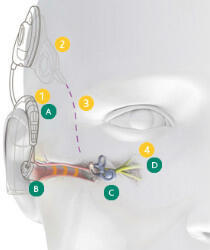Electro-acoustic implants
Obtain more information about how electro-acoustic implants work and when they can be recommended.

Page contents
- The importance of high-frequency sound sounds
- How electro-acoustic implants work
- The indications of electro-acoustic implants
The importance of high-frequency sounds
If someone has a high frequency hearing loss, they can hear some sounds, but not others. These sounds are important for understanding speech. They include consonants, which help distinguish between words and detect emotion. Without these sounds, words can merge, making the conversation heard jumbled and sometimes difficult to understand.
How electro-acoustic implants work?
Electro-acoustic implants have two parts: an external sound processor with an acoustic component and an internal implant.
The cochlear implant increases high-frequency sounds and the acoustic component amplifies natural low-frequency noises.
Electric transmission
- External processor picks up sound and converts it to digital signals.
- The processor sends high frequency digital signals to the implant.
- The implant converts this high-frequency information into electrical signals and sends them to the electrode bundle located inside the cochlea.
- The responses of the auditory nerve to electrical and acoustic stimulation are sent to the brain, which combines them to perceive a sound.
Acoustic transmission
- The external processor sends low frequency sounds to the acoustic component.
- The acoustic component amplifies low-frequency sounds and transmits them along the ear canal.
- Amplified sounds activate the auditory nerve.
- The responses of the auditory nerve to electrical and acoustic stimuli are sent to the brain, which combines them to perceive a sound.
The indications of electro-acoustic implants
If a person with hearing loss can perceive some low-frequency sounds but misses high frequency sounds, an electro-acoustic implant may be a solution.
After running some tests, a hearing specialist will be able to determine if an electro-acoustic implant is the most suitable solution.
Disclaimer
Please seek advice from your health professional about treatments for hearing loss. Outcomes may vary, and your health professional will advise you about the factors which could affect your outcome. Always follow the directions for use. Not all products are available in all countries. Please contact your local Cochlear representative for product information.
For a full list of Cochlear’s trademarks, please visit our Terms of Use page.


